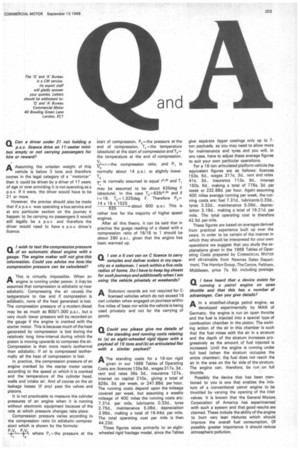Q I wish to test the compression pressure of an automatic
Page 205

If you've noticed an error in this article please click here to report it so we can fix it.
diesel engine with a gauge. The engine maker will not give this information. Could you advise me how the compression pressure can be calculated?
AThis is virtually impossible. When an engine is running under power, it May be assumed that compression is adiabatic or near adiabatic. Compressing the air causes the temperature to rise and if compression is adiabatic, none of the heat generated is lost. The compression pressure of a modern diesel may be as much as 800/1,000 p.s.i., but a very much lower pressure will be recorded on the gauge if the engine is cranked with the starter motor. This is because much of the heat generated by compression is lost during the relatively long time-interval during which the piston is moving upwards to compress the air. Compression is then more nearly isothermal than adiabatic; If air is compressed isothermally all the heat of compression is lost.
In practice, the compression pressure of an engine cranked by the starter motor varies according to the speed at which it is cranked and the temperature of the cylinder head. walls and intake air. And of course on the air leakage losses (if any) past the valves and pistons.
It is not practicable to measure the cylinder pressures of an engine when It is running without electronic equipment because of the rate at which pressure changes take place.
Compression pressure varies according to the compression ratio (in adiabatic compression) which is shown by the formula:
—t—=—TT where P, =the pressure at the start of compression. P2= the pressure at the end of compression, the temperature (absolute) at the start of compression and T2= the temperature at the end of compression.
V
vt= r = the compression ratio, and P, is normally about 14 psi. or slightly lower. T2 is normally assumed to equal r°:33 and T, may be assumed to be about 635deg F (absolute). In this case T2=635r°:" and if r=18, T2= 1.525deg F. Therefore 132=
14 x 18 x 1525 635 —about 600 psi. This is rather low for the majority of higher speed engines.
After all this theory, it can be said that in practice the guage reading of a diesel with a compression ratio of 16/18 to 1 should be about 280 psi., given that the engine has been warmed up.




































































































































































































































































